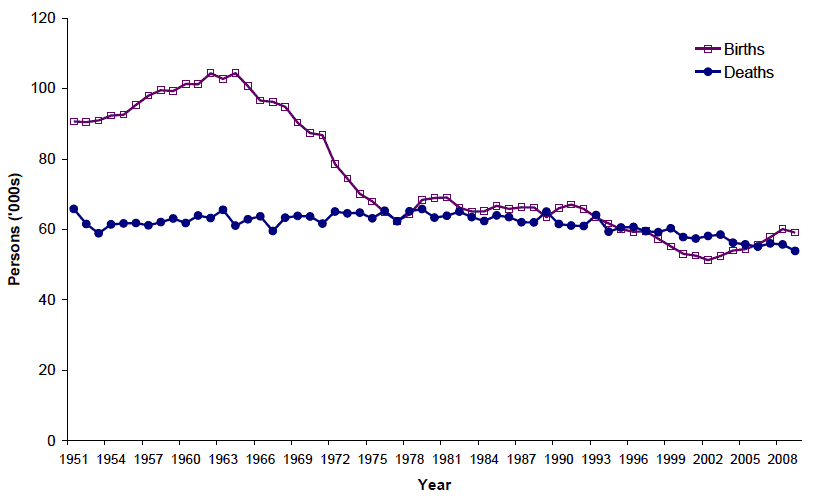
Numbers
59,046 births were registered in Scotland in 2009, 995 (1.7 per cent) fewer than in 2008. This fall followed six consecutive annual increases in the number of births. The total in 2009 was 1,265 (2 per cent) higher than in 2007. However, it was still well below the most recent peak of over 100,000 per year in the early 1960s, and the level of around 65-70,000 per year between the mid-1970s and the early 1990s, as Figure 2.1 shows.
Figure 2.1 Births and deaths, Scotland, 1951-2009

The proportion of births to unmarried parents (including births registered solely in the mother’s name) has continued to rise, reaching 50.3 per cent in 2009 compared to 41.2 per cent ten years earlier and 26.0 per cent in 1989. However, the proportion of births registered solely in the mother’s name was around 6-7 per cent in the 1980s and 1990s, falling over the past decade to 5.4 per cent in 2009, suggesting that the increase in births to unmarried parents has been in babies born to unmarried partners who are in a stable relationship.
Fertility Rates
The simplest fertility rate is the crude birth rate which is defined as the number of live births per 1,000 total population. Appendix 1 Table 1 on page 108 shows that in 2009 the crude birth rate for Scotland stood at 11.4 compared with around 18 forty years ago. Because it takes no account of the age/sex structure of the population, the crude birth rate has only limited value (e.g. for giving rough comparisons between areas with broadly similar age/sex structures). Appendix 1 Tables 2 and 3 show crude birth rates for administrative areas in Scotland and selected European countries. Appendix 1 Table 2 also gives standardised birth rates for the administrative areas of Scotland: these adjusted birth rates take account of the population structures in the different areas.
A better approach is to consider the general fertility rate (GFR) which is based on the numbers of women of childbearing age. Figure 2.2 shows the general fertility rate (births per 1,000 females aged 15-44), along with the number of women aged 15-44. During the ‘baby boom’ of the 1960s, the GFR reached 99.5 (in 1962). It then fell sharply to around 60 during the late 1970s and 1980s before declining more slowly during the 1990s, eventually dipping below 50 at the start of the 21st century. It then rose slightly over the next few years to 57.2 in 2008 but fell to 56.6 in 2009. Interestingly, the female population aged 15-44 was relatively low during the baby boom of the 1960s. Moreover, the levelling off in the annual numbers of births during the 1980s was in part associated with the increasing numbers of women born in the 1950s and 1960s, passing through their childbearing years.
Figure 2.2 Estimated female population aged 15-44 and general fertility rate (GFR), Scotland, 1951-2009
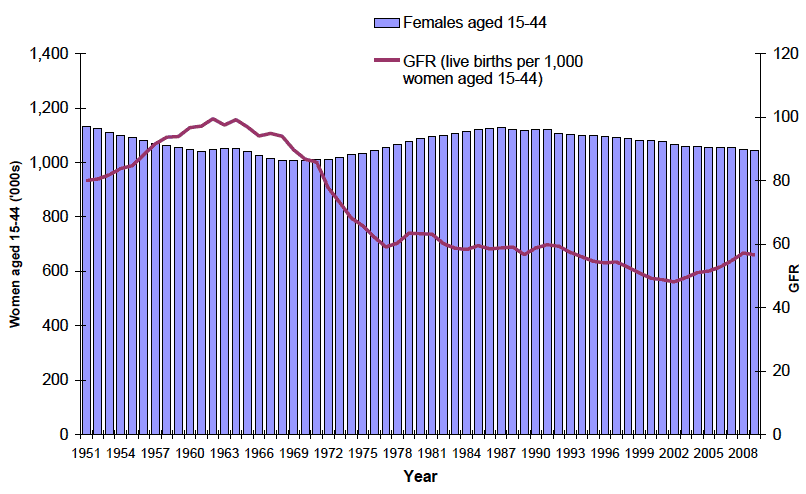
A more detailed picture is given by the age specific fertility rates (ASFRs) by mother’s age, in five-year age groups, in Figure 2.3. This shows many significant age-related features of the pattern of childbearing over the last fifty years. The key point is that, as well as choosing to have fewer babies, women are also choosing to have them later in life. Other points of interest are:
Figure 2.3 Live births per 1,000 women, by age of mother, Scotland, 1951-2009
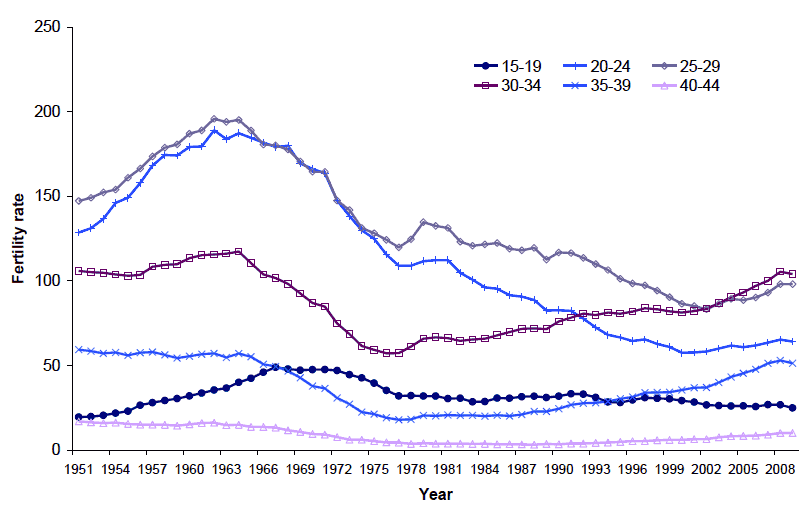
Since the mid-1970s, there has been a trend towards having children at older ages. The percentage of births to mothers aged under 20 fell from about 11 per cent (on average) between 1976 and 1980, and around 8 per cent in 1991-95, to under 7 per cent in 2009. Mothers aged 20-24 accounted for roughly a third of all births in 1976-1980, about 22 per cent in 1991-95, and 19 per cent in 2009. The percentage of births to mothers aged 25-29 has also fallen, from around 35 per cent in 1976-80 and about 36 per cent in 1991-95, to 27 per cent in 2009. As a result, women aged over 30 accounted for nearly half of all births in 2009; 27 per cent were to mothers aged 30-34, 16 per cent were to 35-39 year olds and 4 per cent were to women aged 40 and over. These figures are all above the levels shown in 1976-80 and 1991-95.
Figure 2.4 further illustrates the ageing pattern of fertility by showing detailed ASFRs for selected years: 1951, 1964 (peak number of births), 1977 (end of steep decline), 1991 recent peak) and 2009. Though the levels differed considerably, the age patterns of fertility for 1951, 1964 and 1977 were roughly the same. However, the age distribution for 1991 shows a distinctly older peak and that for 2009 reveals a further reduction in fertility of women in their twenties, mirrored by an increase for women in their thirties, compared with 1977 and 1991.
The trend towards later childbearing is underlined by changes in the average age of mothers for all births. This was 29.4 in 2009, compared with 27.4 in 1991, 26.1 in 1977, and 27.4 in 1964. Similarly, the average age of fathers has increased to 32.3 in 2009 compared with 30.0 in 1991 and 28.6 in 1977. These figures exclude births registered in the mother’s name only, where the father’s details were not provided.
Figure 2.4 Live births per 1,000 women, by age, selected years
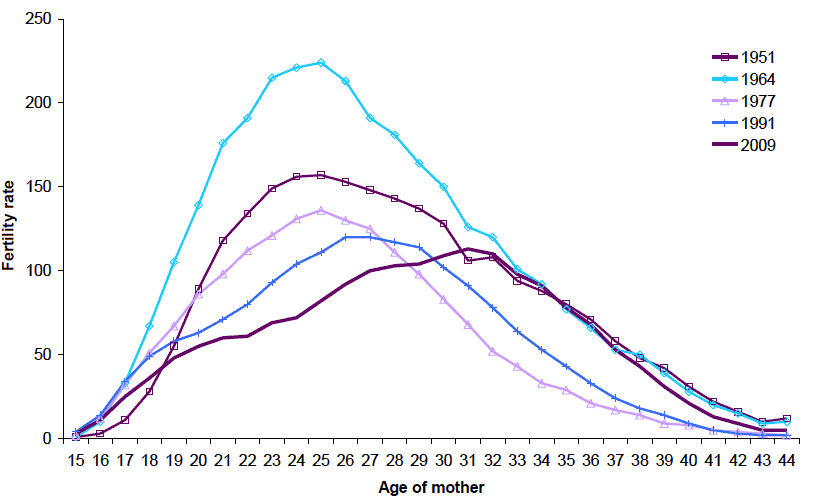
The total fertility rate (TFR) is a commonly used summary measure of fertility levels calculated by summing the age specific rates for a single year. It gives the average number of children that a group of women would expect to have if they experienced the observed ASFRs in each of their childbearing years. For a population to replace itself, the TFR needs to be around 2.1.
The TFR for Scotland since 1951 is plotted in Figure 2.5. Not surprisingly, it follows the same general pattern as the GFR described above. It rose to 3.09 in 1964 before dropping sharply to 1.70 in 1977. Since then, with a few minor fluctuations, it fell more slowly to the 2002 rate of 1.48 before increasing to 1.62 in 2005 and 1.80 in 2008 – its highest level for 26 years. In 2009 the TFR was 1.77.
Figure 2.5 Total fertility rate, Scotland, 1951-2009
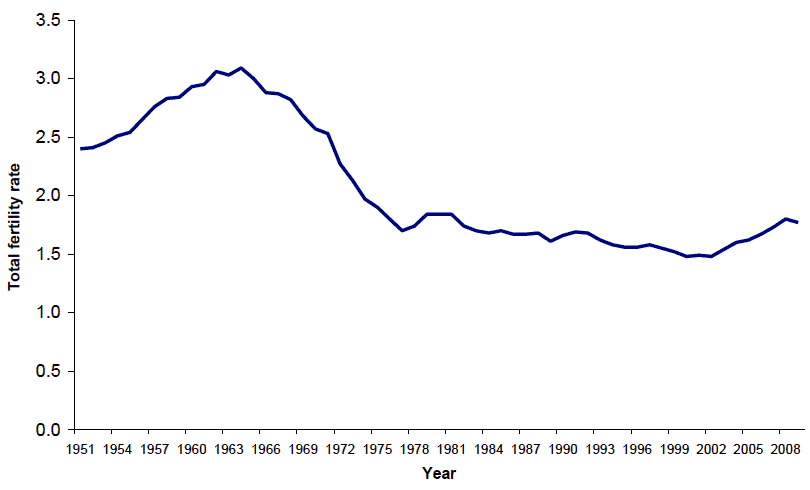
Though widely used, in part because it is relatively easy to calculate, the TFR has serious deficiencies as it is based on only one year’s observations. For example, when women are delaying childbearing, as they have been in Scotland, the TFR is likely to underestimate the number of children women will eventually have.
A more satisfactory measure is average completed family size. Figure 2.6 shows the completed family size (or cumulative cohort fertility) by age for women born in selected years. Those born in 1951 had attained an average completed family size of 2.03 by the time they reached 45, whereas for those born in 1956 and 1961 the figures were 1.93 and 1.87 respectively. The figure also permits the comparison of family size at selected ages for the various cohorts as they pass through the childbearing ages. Of crucial importance is the extent to which the later cohorts are falling behind in family building. For example, by age 30 the cumulative childbearing of the 1976 cohort was about 0.5 lower than that of the 1956 cohort. The 1981 cohort are the first in decades to show a higher fertility rate than the cohort before them. Whilst the increasing fertility rates of those aged over 30 may lead to further catching-up, it is highly unlikely that this will increase the average completed family size to the levels attained as recently as the cohorts born in the 1960s.
Figure 2.6 Cumulative cohort fertility rate for selected birth cohorts, Scotland
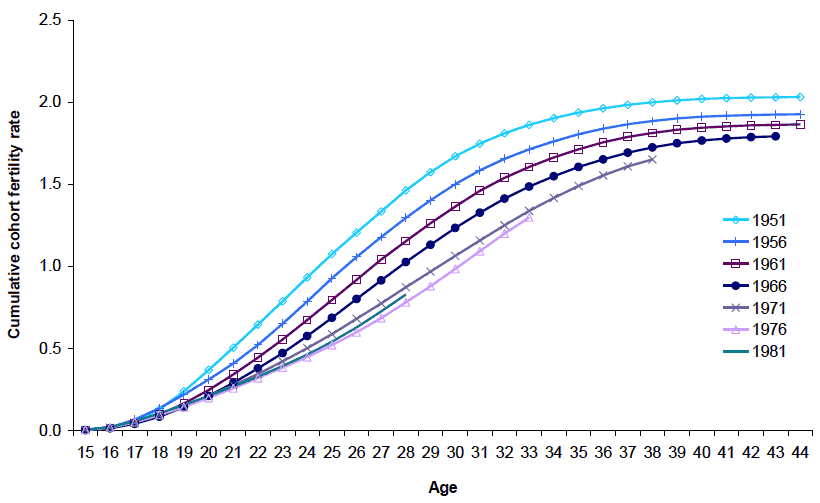
Since the early 1980s, Scotland’s fertility has been lower than fertility in the other parts of the United Kingdom. Figure 2.7 compares the TFRs for England, Wales, and Northern Ireland since 1971 with those for Scotland. Until the late 1970s, Scotland’s TFR was slightly higher than that for England and Wales. However, since the early 1980s, Scotland’s TFR has dropped steadily below the levels for England and Wales. In 1971, the TFR for Northern Ireland was markedly higher than for the other three countries. But since then the differential has been significantly reduced. The recent rise in fertility levels in Scotland has been paralleled elsewhere in the UK as has the downturn in 2009, except in England where the TFR remained at the 2008 level.
Figure 2.7 Total fertility rates, UK countries, 1971-2009
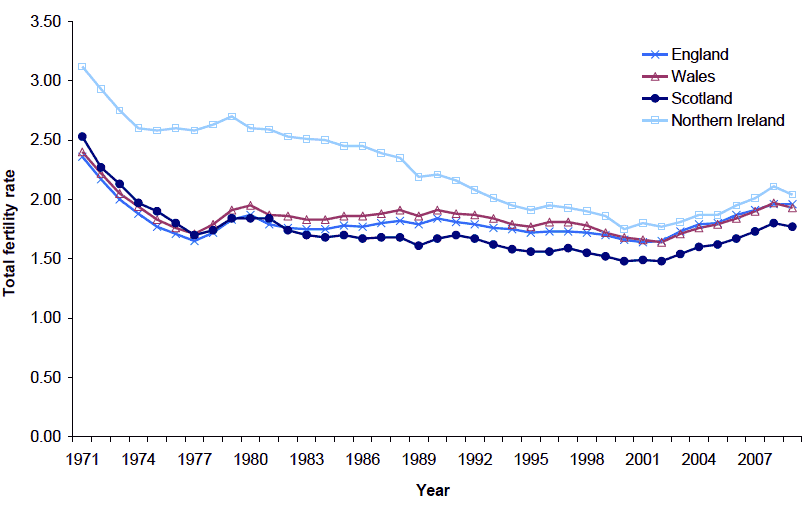
Country of birth of parents
86 per cent of births in 2009 were to mothers who had been born in the UK, including 76 per cent to women who were born in Scotland. A further 6 per cent of mothers had been born elsewhere in the European Union, including 3.5 per cent from the countries which joined the EU in 2004 (like Poland). Commonwealth countries were the birthplace of 5 per cent of mothers including 2 per cent from the Indian sub-continent. In the cases where the father’s country of birth was known, 87 per cent had been born in the UK, including 75 per cent who were born in Scotland.
Considering only births for which both the mother’s and the father’s countries of birth were known, in 14 per cent of births in 2009 neither parent was born in Scotland and in 9 per cent of births neither was born in the UK. These figures compare to 9 per cent and 3 per cent respectively in 2003. The numbers of births to parents from EU and non-EU countries have both increased over this period.